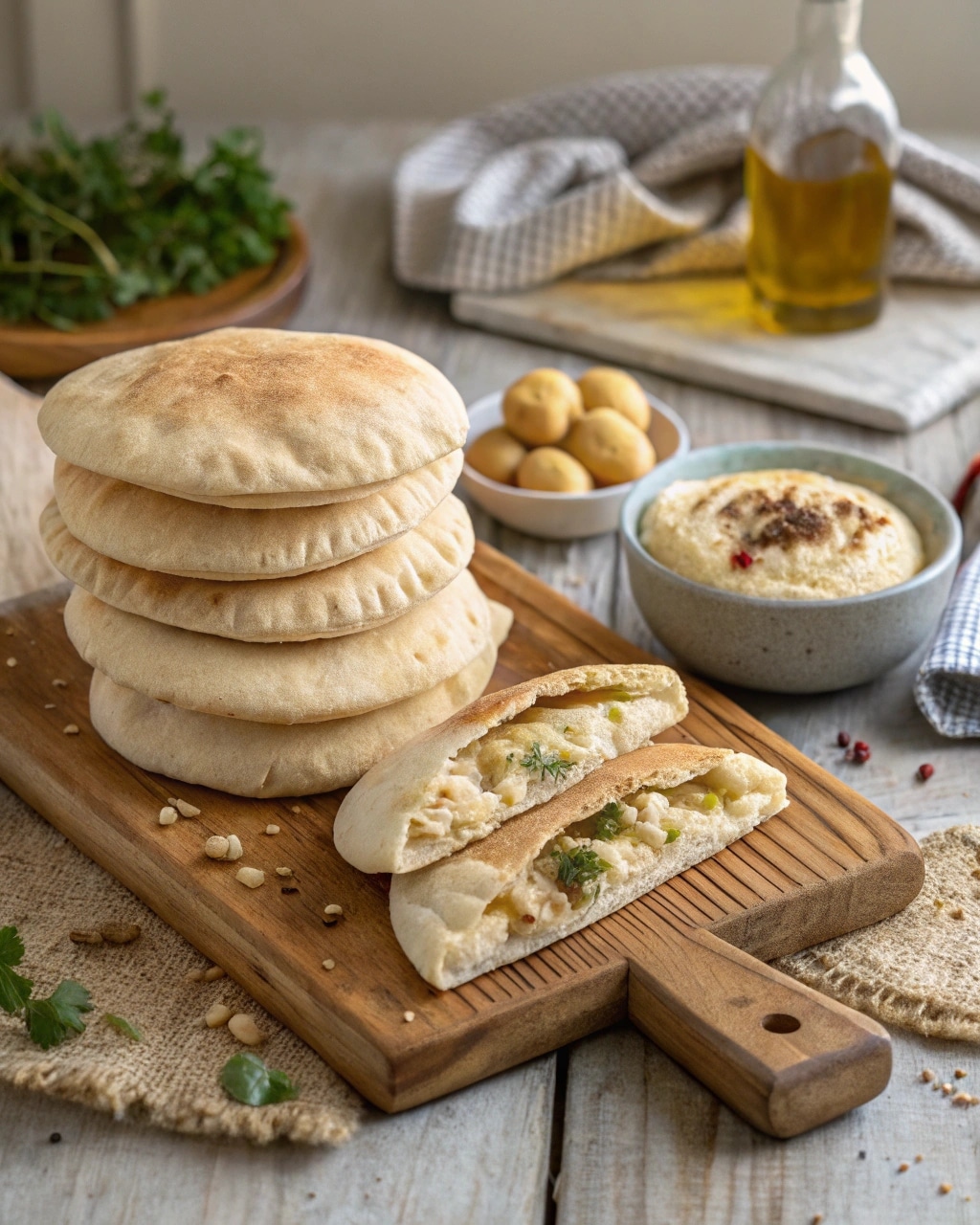There’s something magical about watching pita bread puff on a hot pan. I remember the first time I saw it as a child, peeking over the countertop in my Kyoto home. My grandmother, wise and gentle, would press each round with purpose, her fingers dusted with flour. That memory came back to me years later in California, when I stood in my own kitchen trying to recreate that same magic—except this time, it had to be gluten free.
I was diagnosed with gluten intolerance during my college years in the US. At first, it felt like I had lost a bridge back to my roots—how could I enjoy the soft flatbreads, the warm wraps, and comforting textures I grew up with? But the little box of handwritten recipes I brought from Japan became my guiding light. I experimented, failed a dozen times, then finally found something that made me gasp the way my grandmother once did: a gluten free pita that actually puffed.
This gluten free pita bread recipe is not just about being allergy-friendly—it’s about reviving tradition in a modern kitchen. It’s yeast-free, flexible, and ready in under 30 minutes. Whether you’re filling it with grilled chicken, roasted veggies, or just tearing it to dip into hummus, it’s a simple comfort that connects memory to now.
You’ll find this recipe surprisingly forgiving, and the ingredients are likely already in your pantry. And unlike many store-bought options, this one’s soft enough to fold, warm enough to satisfy, and honestly—it’s the only gluten free pita I’ll ever need.
INGREDIENTS: Soft & Simple Gluten Free Pita Dough
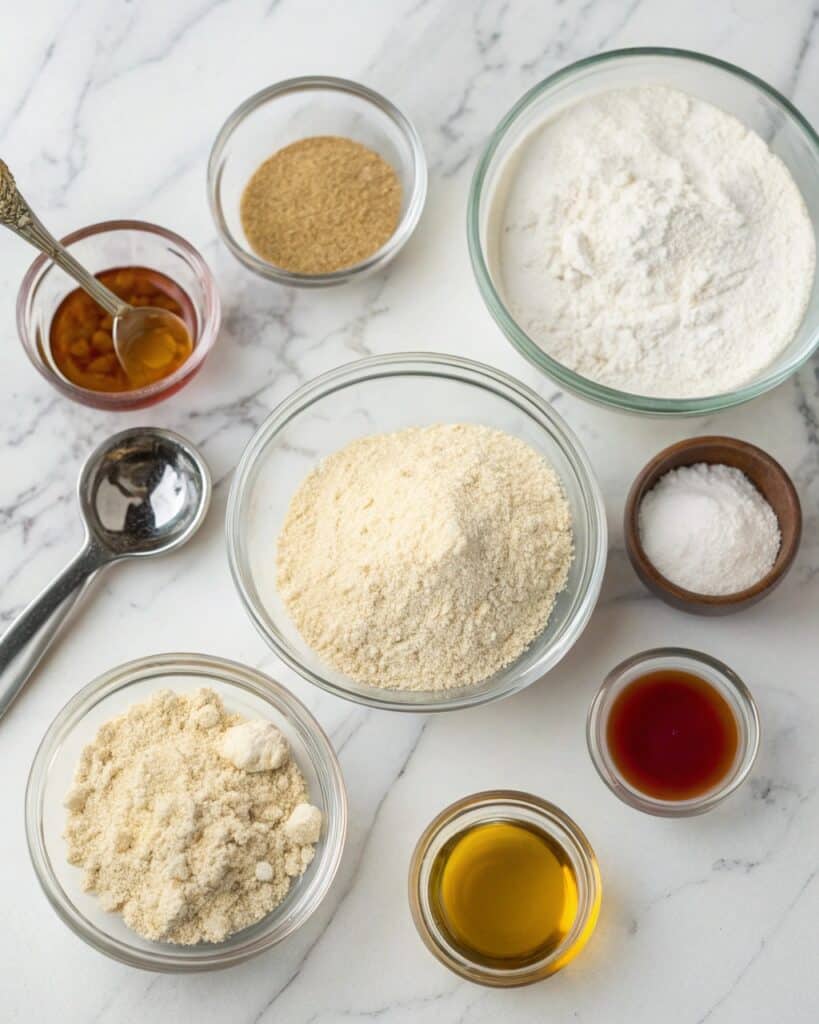
Essential Pantry Staples
Here’s what you’ll need to make about 6 medium gluten free pita breads:
| Ingredient | Amount |
|---|---|
| Gluten-free all-purpose flour (with xanthan gum) | 2 cups (240g) |
| Baking powder | 2 teaspoons |
| Salt | 1 teaspoon |
| Psyllium husk powder | 1 tablespoon |
| Warm water (110°F) | 1 cup (240ml) |
| Olive oil | 2 tablespoons |
| Apple cider vinegar | 1 teaspoon |
Optional Add-ins:
- Garlic powder or za’atar for flavoring the dough.
- A pinch of sugar if you prefer a slightly sweeter taste.
Instructions – How to Make Gluten Free Pita Bread
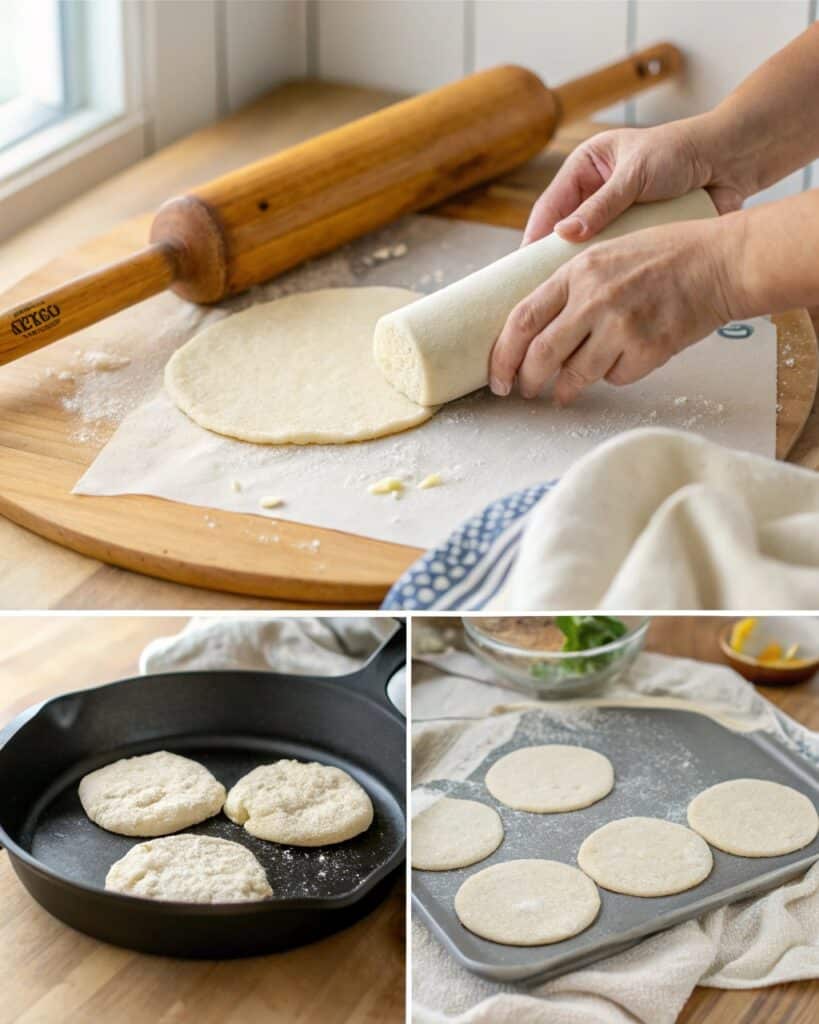
Gluten free dough can feel intimidating at first, but this pita bread recipe is designed for success—even for beginners. The dough comes together quickly and cooks up beautifully in a hot pan, puffing into soft rounds ready to fill or dip. You won’t need any fancy tools or special yeast skills—just a bowl, a rolling pin, and a skillet.
Easy Step-by-Step Pita Prep
- Combine dry ingredients.
In a large bowl, mix 2 cups of gluten-free flour with 2 teaspoons of baking powder, 1 teaspoon of salt, and 1 tablespoon of psyllium husk powder. - Mix in liquids.
Add 1 cup of warm water, 2 tablespoons of olive oil, and 1 teaspoon of apple cider vinegar. Stir until a soft, sticky dough forms. - Rest the dough.
Let the dough sit for 10 minutes to thicken as the psyllium absorbs moisture. Meanwhile, heat a cast iron or nonstick skillet over medium-high. - Divide and roll.
Lightly flour a surface. Divide the dough into 6 balls and roll each into a 6-inch circle, about ¼ inch thick. - Cook to perfection.
Place one pita round in the hot dry skillet. Cook for 2 to 3 minutes until bubbles appear, then flip and cook the other side for 2 more minutes. Flip once more to help it puff up. - Repeat and wrap.
Move the cooked pitas to a clean towel to stay warm. Continue the process with the remaining dough.
You can enjoy these warm or reheat them later. Even if one doesn’t puff, it’ll still be soft, bendable, and just right for sandwiches or wraps.
This quick-cook method is much like the one I use for my garlic bread pizza recipe, where high-heat cooking turns soft dough into crispy, golden goodness. And if you’re new to gluten-free baking, recipes like my ezekiel bread offer another great way to explore hearty, nourishing alternatives.
For another creative twist on low-carb, gluten-free bread, try this clever flourless cottage cheese bread from Greaty Recipes—it’s fluffy, light, and protein-packed.
Serving – How to Enjoy Gluten Free Pita Bread
There’s no wrong way to enjoy warm, puffed gluten free pita bread—but there are many delicious ones! This versatile flatbread is more than just a sandwich holder; it’s a cozy canvas for everything from hummus to hearty fillings. And the best part? Its soft, tender bite makes it friendly to all kinds of toppings, dips, and spreads.
Stuff, Dip, or Wrap It Up
The classic move is slicing your pita in half and filling the pocket. Try grilled chicken, lettuce, and tzatziki for a Greek-inspired lunch. Or make it vegan with falafel, roasted eggplant, and tahini. Want something light and vibrant? Fill the pita with sliced cucumber,a layer of hummus , and red pepper.
If your pita doesn’t puff fully—don’t worry! It still makes a wonderful wrap. Just lay it flat, pile on your favorites, and roll it up. You can also cut it into triangles, bake them until crisp, and serve with dips like baba ghanoush or guacamole.
Inspired by my spoon bread recipe, I sometimes use these pita rounds as a side with hearty soups or baked dishes. Their tender texture makes them ideal for soaking up sauces and gravies. And when you’re craving something creative, turn your pita into a personal pizza—just like I do with my amish cinnamon bread by layering sweet or savory toppings for a fast flatbread meal.
Craving something more unique? You might love the fresh and slightly sweet take from cottage cheese blueberry cloud bread—it’s fluffy, protein-rich, and a great pairing with fruit-forward spreads.
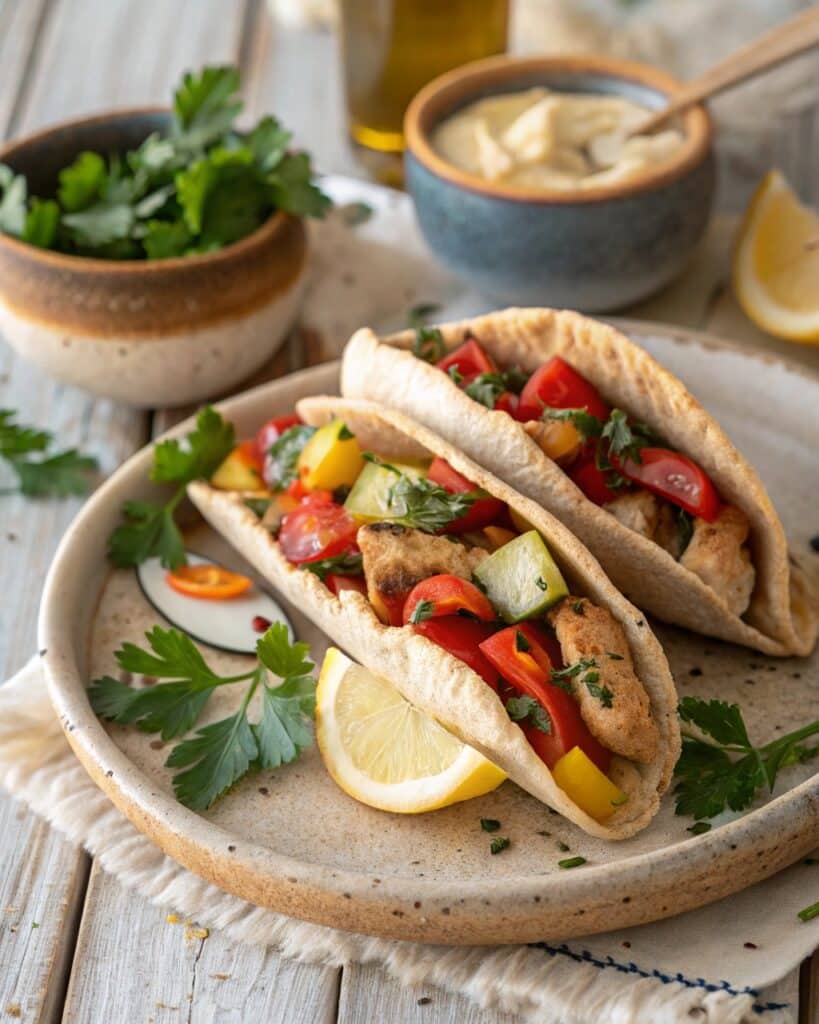
Nutrition – What’s Inside Gluten Free Pita Bread
When you bake your own gluten free pita bread at home, you get full control over what goes in—and what stays out. No preservatives. No unpronounceable additives. Just wholesome ingredients you likely already have, combined to create a flatbread that’s satisfying, soft, and nourishing.
Calories, Carbs & Protein – A Balanced Bite
Here’s a breakdown of the nutrition per one medium pita (based on this recipe, making 6 total):
| Nutrient | Amount (Approx.) |
|---|---|
| Calories | 140 |
| Carbohydrates | 24g |
| Dietary Fiber | 4g |
| Protein | 3g |
| Total Fat | 4.5g |
| Saturated Fat | 0.6g |
| Sodium | 290mg |
| Sugar | 0g |
| Cholesterol | 0mg |
Thanks to the psyllium husk, this gluten free pita offers a decent amount of fiber, helping with satiety and digestion. There’s no added sugar, and the fat mainly comes from the olive oil—which contributes heart-healthy monounsaturated fats.
If you’re watching carbs, this recipe contains fewer than typical wheat-based pitas. It’s also lower in protein compared to some commercial options, but pairing it with fillings like lean meats, eggs, or spreads like hummus can balance the plate. For example, I often serve it with leftovers from my king arthur bread machine recipe crust or with a slice of bisquick banana bread for a contrasting texture in brunch platters.
Want to go lighter or dairy-free? That’s easy with this recipe. And for a breakfast-friendly gluten free alternative, the cottage cheese gluten-free pancakes from Greaty Recipes are another delicious, protein-forward option to keep your mornings satisfying and simple.
This pita bread is not just a substitute but a wholesome and reliable choice you’ll come back to regularly.
Frequently Asked Questions
Is there gluten-free pita?
Yes, there is! Traditional pita contains wheat, but gluten-free pita recipes like this one use blends of gluten-free flours with psyllium husk or binders to replicate the soft, puffed structure. Many grocery stores also carry gluten-free pita, but homemade options are usually fresher and softer.
Does gluten-free pita have carbs?
Absolutely. While it’s free from wheat gluten, it still contains carbs from gluten-free flours like rice or tapioca. This recipe has about 24g of carbs per medium pita—lower than some traditional breads but not carb-free.
Is keto pita gluten-free?
Some keto pita recipes are gluten-free, especially if they’re made with almond flour, coconut flour, or cheese-based doughs. However, not all gluten-free pitas are keto, as they often still include starches or grains like rice flour.
What is a good substitute for pita bread?
Good gluten-free substitutes include rice wraps, corn tortillas, cassava flatbreads, or cloud bread. For a soft and fluffy option, you can also try cloud bread recipes made with cottage cheese for a grain-free alternative.
Conclusion
Making your own gluten free pita bread brings warmth, flavor, and flexibility back into your meals. It reconnects tradition with dietary needs, and reminds us that the joy of cooking comes from adaptation and heart. Whether you’re stuffing them with Mediterranean flavors, toasting them for chips, or simply enjoying them warm with olive oil, these pitas are more than bread—they’re a soft, foldable piece of comfort.
From my Kyoto kitchen to yours in the US, I hope this recipe brings as much satisfaction to your table as it does to mine.
Print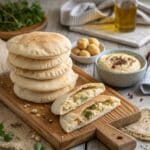
Gluten Free Pita Bread Recipe That Actually Puffs – Soft, Simple & Delicious
- Total Time: 25 minutes
- Yield: 6 pitas 1x
Description
Soft and puffed gluten free pita bread recipe that’s ready in under 30 minutes. Yeast-free, tender, and perfect for wraps, dips, and sandwiches.
Ingredients
2 cups gluten-free flour (with xanthan gum)
2 tsp baking powder
1 tsp salt
1 tbsp psyllium husk powder
1 cup warm water
2 tbsp olive oil
1 tsp apple cider vinegar
Instructions
1. Whisk all dry ingredients in a bowl.
2. Add wet ingredients and stir to form dough.
3. Let rest 10 minutes to absorb moisture.
4. Divide into 6 balls, roll into 6-inch rounds.
5. Heat a dry skillet on medium-high.
6. Cook each pita 2–3 minutes per side, flipping until puffed.
7. Keep warm in a towel. Serve fresh.
Notes
You can add garlic powder or za’atar to the dough for extra flavor.
If pitas don’t puff, they still work great as wraps or flatbreads.
- Prep Time: 10 minutes
- Cook Time: 15 minutes
- Category: Bread, Flatbread
- Method: Skillet
- Cuisine: Gluten-Free
Nutrition
- Serving Size: 1 pita
- Calories: 140
- Sugar: 0g
- Sodium: 290mg
- Fat: 4.5g
- Saturated Fat: 0.6g
- Unsaturated Fat: 3.8g
- Trans Fat: 0g
- Carbohydrates: 24g
- Fiber: 4g
- Protein: 3g
- Cholesterol: 0mg

